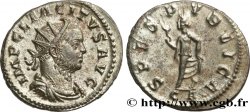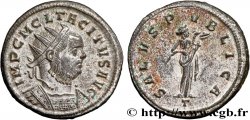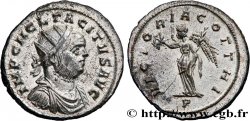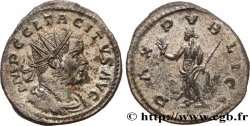v59_0519 - TACITUS Aurelianus
MONNAIES 59 (2013)
Starting price : 550.00 €
Estimate : 850.00 €
Realised price : 590.00 €
Number of bids : 2
Maximum bid : 703.00 €
Starting price : 550.00 €
Estimate : 850.00 €
Realised price : 590.00 €
Number of bids : 2
Maximum bid : 703.00 €
Type : Aurelianus
Date: 276
Mint name / Town : Ticinum
Metal : bronze
Diameter : 21 mm
Orientation dies : 12 h.
Weight : 3,40 g.
Rarity : R3
Officine: 1re
Emission: 2e
Coments on the condition:
Exemplaire sur un flan ovale, bien centré des deux côtés. Très beau portrait inhabituel de Tacite. Joli revers. Patine marron foncé avec des reflets métalliques. Conserve une partie de son brillant de frappe et de son coupant d’origine
Catalogue references :
Predigree :
Cet exemplaire provient de MONNAIES XXIV, n° 629 et de la collection Daniel Compas “antoniniani et aureliani exceptionnels”
Obverse
Obverse legend : IMP C M CL TACITVS AVG.
Obverse description : Buste radié et cuirassé de Tacite à gauche, vu de trois quarts en avant (B1).
Obverse translation : "Imperator Cæsar Marcus Claudius Tacitus Augustus", (L'empereur césar Marc Claude Tacite auguste).
Reverse
Reverse legend : PAX A-V-G-VSTI/ -|-// P.
Reverse description : Pax (la Paix) debout à gauche, brandissant de la main droite une branche d'olivier et tenant de la main gauche un long sceptre transversal.
Reverse translation : "Pax Augusti", (La Paix de l'auguste).
Commentary
Poids léger. Avec son argenture superficielle. Rubans de type 3 aux extrémités bouletées. Cuirasse cloutée. Épaulière ornée d’une palme. Ptéryges fines. Type de portrait exceptionnel (graveur lyonnais). Semble de même coin de droit que l’exemplaire du Cabinet des médailles de la BnF (BN/RXII.1 n° 1673). Cet exemplaire est mentionné avec photo dans le RIC. temp. 3395 (n° 13).








 Report a mistake
Report a mistake Print the page
Print the page Share my selection
Share my selection Ask a question
Ask a question Consign / sell
Consign / sell
 Full data
Full data



